
Food items and gaming keyboards should never mix. But regardless of how careful you are, it’s not a matter of if accidents can happen, it’s a matter of when. To have your keyboard drenched by a toppled glass of liquid is a nightmare scenario, and can easily happen to the best of us. So I intentionally did it to Corsair's keyboard.
To mitigate unhappy accidents, Corsair designed the K68 “spill resistant” mechanical keyboard. The K68 has an Ingress Protection (IP) marking of IP32, and should therefore be able to ward off particulates larger than 2.5mm and dripping water. This is achieved by surrounding each of its Cherry MX Red switch with a silicone flood wall.
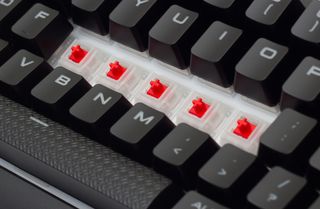
The K68’s IP32 rating is impressive, but it’s not the highest we’ve seen. That honor goes to the Razer Blackwidow Ultimate and its IP54 rating. Whereas the Corsair K68 uses rubber floodwalls, the Razer Blackwidow Ultimate’s switch casings are inherently water resistant.
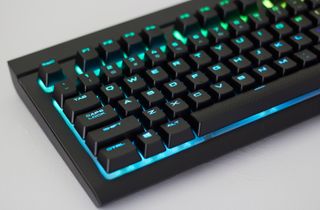
Nonetheless, Corsair’s confidence in the K68’s durability has me itching to run it through a few real-life scenarios to test its true mettle.
The test
Adam Savage once said: “The only difference between screwing around and science is writing it down.” And today, I'm going to science plenty.
The K68 will be put through three trials. First, it will be sprinkled with a tasty mix of Cheetos and Doritos dust lightly seasoned with crushed crème donuts. If it survives, it will be doused in a healthy helping of nacho cheese and oatmeal. And what better way to compliment the flavors than 50ml of cream soda? The K68 must survive all three tests to be deemed worthy.
To establish a baseline, we’ll also subject a non-IP rated mechanical keyboard, the HyperX Alloy FPS, to the same grueling set of tortures. Both keyboards will be plugged in throughout the duration of the test. They will be considered defunct when they either stop registering keystrokes or cease to operate.
The biggest gaming news, reviews and hardware deals
Keep up to date with the most important stories and the best deals, as picked by the PC Gamer team.
Cheetos, Doritos, and crème donuts
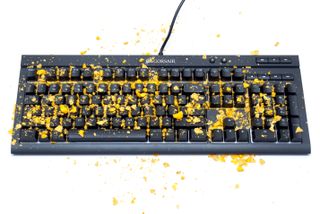
I wasn't expecting either keyboards to be affected by mere crumbs, and I was right! After brushing away some larger fragments that were jamming the keys, both keyboards continued to operate as normal.
Nacho cheese and oatmeal

I'm no Gordon Ramsay, but our nacho cheese and oatmeal spread is guaranteed delicious. Normally, when you add any fluid to keyboards, they simply stop working. That’s not the case with the Corsair K68 as it happily gobbled up our mixture without issue.
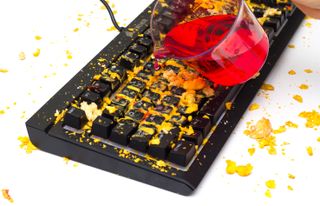
The K68 faired well, but the HyperX Alloy FPS did not meet the same fate. After feeding it some nacho cheese, a good portion of the keys stopped working and the space bar started to glitch. That’s to be expected, however, as it’s not meant to be punished like this.
Soda
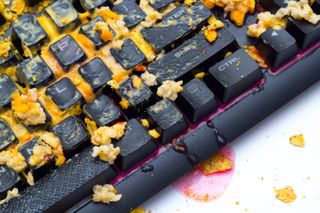
This liquid is the most likely candidate to spill on a gamer’s keyboard. I personally prefer coffee, but the bright pink Crème soda is easier to see. The K68 easily shrugged off the sugary bath, and interestingly, I noticed that the liquid overflowed the bottom edge when we poured too much. This means that unless you empty an entire bottle onto the keyboard in one go, a slow, continuous flow should pose no immediate threat.
Conclusion
Messing up the K68 isn’t a problem; the real headache is the cleanup. The rubber flood gates prevent liquids from penetrating the switches when the keyboard is stationary, but they can be breached if the keyboard is tilted or moved around. This meant that I needed to keep the K68 still until I could drain all the liquids.
By the end of testing, the keyboard was a caked in a goo—everything was just stuck together. I sucked up the soda using paper towels, and then scooped up the remaining nacho cheese using a folded cloth. Some chip particles got pushed into the switches but they were easy enough to pick out. With the liquids out of the way, I turned the keyboard upside down and shook out whatever loose chip parts was still in there. Then I wiped it down with a damp cloth, removing as much of the residuals as I could. Overall, it took me a good hour to get the keyboard completely clean, and we were more than tempted to just run it under the sink on multiple occasions.
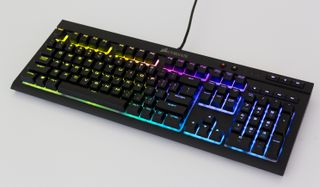
The K68 survived—without any dead keys. Unless an entire refreshments table tilts onto your keyboard, a disaster of this magnitude will most likely never happen to you. This worst-case scenario, however, highlights the K68’s exceptional ability to withstand truly punishing conditions. Unfazed by solids, liquids, and gel, gamers can afford to be careless around the K68.
Most Popular


